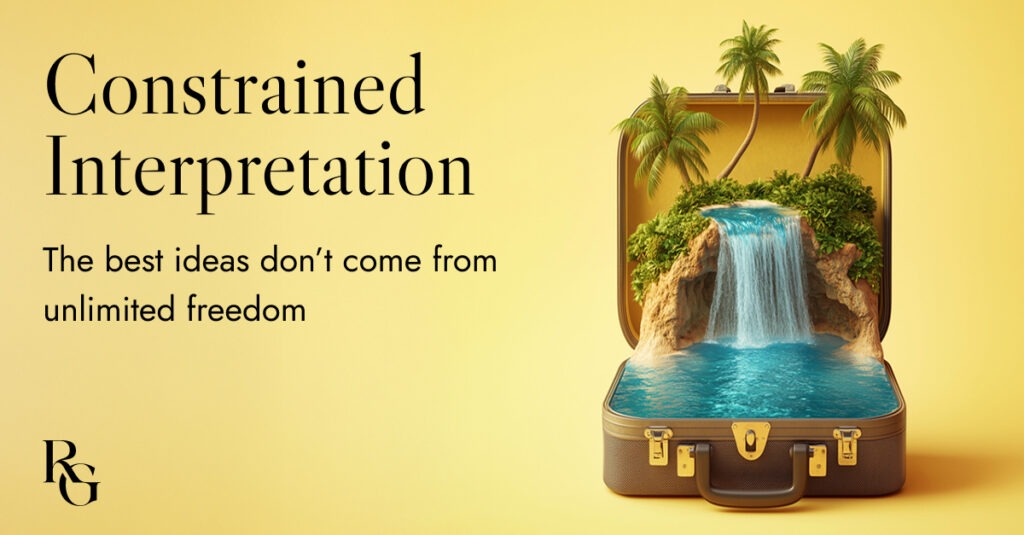
By James Dowd
Creativity, at its core, demands a bit of chaos. It thrives in the unexpected, the messy, the bold strokes and wild ideas that often lead us to breakthroughs we wouldn’t have imagined otherwise.
But here’s the thing: unchecked creativity can spiral out of control, off into the wrong direction. What starts as imaginative problem-solving can wander into creative wilderness, wasting time and resources as you search for something — anything — that fits the brief.
That’s where Constrained Interpretation comes in – the control in the chaos. It’s a concept of leading and directing (especially as a creative director) without stifling creativity. Think of it as creating the box: defined borders that keep the work tethered to the vision, while still leaving plenty of room to play. When you hand off a brief or task to someone, you’re setting the groundwork for their creativity to go on and get shit done. But Constrained Interpretation then limits the extent to which someone can interpret that brief or task. It draws the line between “creative freedom” and “creative free-for-all.” You want them to solve problems, sure, but without drifting too far from the intended direction. It’s the difference between giving someone a map and saying, “Go explore the city,” versus sharing stories about your favorite spots to inspire their visit.
Sharpening, Not Limiting
And that’s the point – Constrained Interpretation doesn’t limit creativity, it directs it. By setting parameters, you’re actually empowering people to be more effective in their creative efforts. You’re giving them a structure to riff within. A sandbox to play in. A key location to visit.
Consider a painter. Give them a blank canvas, and they might struggle to know where to start. But, give them a theme — some constraints — and suddenly they can dive in, pushing the boundaries of their creativity within the guidelines you’ve given. The theme, in this case, is the box. It’s not a restriction; it’s the thing that gives their work purpose and direction.
The AI Connection
Constrained Interpretation helps humans stay focused and is even more critical when working with AI. Unlike people, AI has no instinct for context. It only knows what you feed it. A wide-open prompt gives you wide-open noise.
The box becomes everything. The tighter and smarter the constraints, the sharper the output. A vague prompt like “Write something about marketing” sends AI wandering, while a prompt like “Write a 200-word blog intro about how constraints drive innovation, using an example from design” locks the AI onto a clear path.
The difference is humans can self-correct when they drift. AI can’t. Constrained Interpretation is the safeguard that makes sure the machine delivers something useful instead of something hollow.
The framework matters now more than ever. The same discipline that keeps creative teams on track is the one that turns AI from a random generator into a reliable collaborator.
The Method to the Madness
Constrained Interpretation is the making of that box. It’s setting up a framework that guides creative exploration while ensuring the outcome is always tethered to the original vision. It’s a bit like having a bungee cord attached — you can leap as far as you want, but eventually, you snap back to where you need to be. That’s the beauty of it.
In practice, Constrained Interpretation can look like tightening up a brief with key details that must be adhered to while leaving enough room for creative freedom in the execution. Or it might involve outlining the non-negotiables — things that must stay intact no matter what creative solutions are proposed. The same is true for AI: a loose prompt sends it wandering, but a well-framed box produces sharper, more relevant output. Either way, it’s about giving just enough guidance to direct the creative process without choking it.
Ultimately, creativity – whether human or machine – requires a bit of madness. But Constrained Interpretation is the method to that madness. It’s the tool that takes wild, unbridled creativity and channels it into something that’s focused, powerful, and aligned with the task at hand. By making the box, you’re not just limiting what’s possible — you’re shaping the potential for creativity to thrive, efficiently and effectively.
It’s the guide that lets ideas grow wild but not aimless, shaping innovation while cutting out wasted time. So, let creativity breathe, but give it just enough space to thrive without getting lost out there.
The box isn’t a limit; it’s the launchpad.